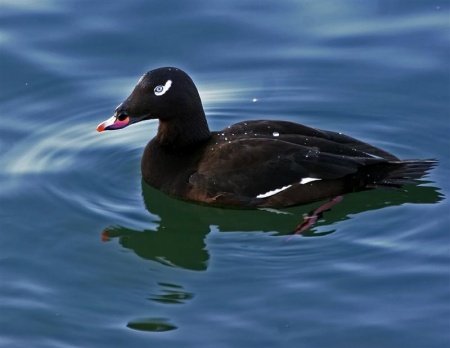(range and taxonomy) |
|||
| Line 1: | Line 1: | ||
| − | [[ | + | [[Image:Velvet_Scoter.jpg|thumb|450px|right|White-winged Scoter (American)<br />Photo by {{user|digitalbirder|digitalbirder}}<br />Location: White Rock, [[British Columbia]], [[Canada]]]] |
;[[:Category:Melanitta|Melanitta]] fusca | ;[[:Category:Melanitta|Melanitta]] fusca | ||
| − | + | '''Includes Velvet Scoter''' | |
| − | + | ||
==Identification== | ==Identification== | ||
51-58cm. Black, white 'tear drop' just behind the eye, yellow long bill, thick neck and pointed tail. In flight, it shows a white patch on the rear of the wing. | 51-58cm. Black, white 'tear drop' just behind the eye, yellow long bill, thick neck and pointed tail. In flight, it shows a white patch on the rear of the wing. | ||
==Distribution== | ==Distribution== | ||
| − | [[Scandinavia]] | + | Breeds in northern areas around the globe, such as [[Scandinavia]] (especially [[Sweden]] and [[Norway]]), northern [[Asia]], and northern [[North America]]. |
| + | |||
| + | Migrates in winter to areas that have coastal open water, for example in [[Europe]] will be found from Norway to [[Spain]] and east to the Caspian Sea. | ||
==Taxonomy== | ==Taxonomy== | ||
| + | [[Image:Velvet_Scoter2.jpg|thumb|450px|right|"Velvet Scoter", Eurasian ''fusca'' <br />Photo by {{user|Gwynn|Gwynn}}<br />Location: [[Austria]]]] | ||
| + | Three subspecies are currently recognized: | ||
| + | *''deglandi'' occurs in North America and includes ''dixoni'' which is no longer recognized. This subspecies has in the past and is increasingly again recognized as a full species, which would keep the name of White-winged Scoter. Opus follows the developments in the worldwide checklists. | ||
| + | *''fusca'' is found in Europe and western Asia, this becomes Velvet Scoter is the split of American birds goes through. | ||
| + | *''stejnegeri'' is found in Estern Asia. This form is also sometimes proposed for recognition as a full species, Asian White-winged or Stejneger's Scoter. | ||
| + | |||
==Habitat== | ==Habitat== | ||
Lakes, coastal waters, estuaries. | Lakes, coastal waters, estuaries. | ||
| Line 18: | Line 26: | ||
<flashmp3>Melanitta fusca (song).mp3</flashmp3><br /> | <flashmp3>Melanitta fusca (song).mp3</flashmp3><br /> | ||
''[[Media:Melanitta fusca (song).mp3|Listen in an external program]]'' | ''[[Media:Melanitta fusca (song).mp3|Listen in an external program]]'' | ||
| + | ==References== | ||
| + | # Clements, James F. 2007. ''The Clements Checklist of Birds of the World''. 6th ed., with updates to October 2007. Ithaca: Cornell University Press. ISBN 9780801445019 | ||
| + | {{ref}} | ||
| + | |||
==External Links== | ==External Links== | ||
{{GSearch|Melanitta+fusca}} | {{GSearch|Melanitta+fusca}} | ||
| − | [[Category:Birds]] | + | [[Category:Birds]] [[Category:Melanitta]] |
Revision as of 18:23, 12 September 2009
- Melanitta fusca
Includes Velvet Scoter
Identification
51-58cm. Black, white 'tear drop' just behind the eye, yellow long bill, thick neck and pointed tail. In flight, it shows a white patch on the rear of the wing.
Distribution
Breeds in northern areas around the globe, such as Scandinavia (especially Sweden and Norway), northern Asia, and northern North America.
Migrates in winter to areas that have coastal open water, for example in Europe will be found from Norway to Spain and east to the Caspian Sea.
Taxonomy
Three subspecies are currently recognized:
- deglandi occurs in North America and includes dixoni which is no longer recognized. This subspecies has in the past and is increasingly again recognized as a full species, which would keep the name of White-winged Scoter. Opus follows the developments in the worldwide checklists.
- fusca is found in Europe and western Asia, this becomes Velvet Scoter is the split of American birds goes through.
- stejnegeri is found in Estern Asia. This form is also sometimes proposed for recognition as a full species, Asian White-winged or Stejneger's Scoter.
Habitat
Lakes, coastal waters, estuaries.
Behaviour
The diet includes shellfish, crabs, sea urchins, fish, insect larvae and plants.
It builds a lined nest on the ground close to the sea, lakes or rivers, in woodland or tundra. 7-9 eggs are laid.
Bird Song
<flashmp3>Melanitta fusca (song).mp3</flashmp3>
Listen in an external program
References
- Clements, James F. 2007. The Clements Checklist of Birds of the World. 6th ed., with updates to October 2007. Ithaca: Cornell University Press. ISBN 9780801445019
Recommended Citation
- BirdForum Opus contributors. (2024) White-winged Scoter. In: BirdForum, the forum for wild birds and birding. Retrieved 23 April 2024 from https://www.birdforum.net/opus/White-winged_Scoter





